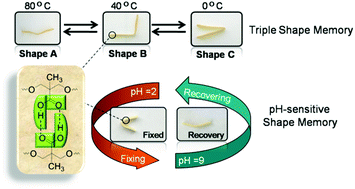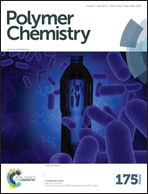Thermo- and pH-sensitive shape memory polyurethane containing carboxyl groups†
Abstract
A type of polyurethane with a thermo-induced triple shape memory effect and a pH-sensitive dual shape memory effect has been developed. Firstly, a series of polyurethanes were successfully synthesized through solution polymerisation of polyethylene glycol (PEG, Mn = 4000 kg mol−1), dimethylolpropionic acid (DMPA) and 4,4′-diphenylmethane diisocyanate (MDI). These polymers were named as PEG-i-MDI-DMPA (i = 20%, 30%, 40%), and i represents the weight content of PEG in the polymers. The results of shape memory testing showed that the PEG-30%-MDI-DMPA displays both the triple-shape memory effect and the pH sensitive dual-shape memory effect. In PEG-30%-MDI-DMPA, the glass transition of PEG chains and the association and disassociation of carboxylic dimers act as two switches to control the triple-shape memory effect, while the carboxylic dimer is affected by pH values to associate in acidic solutions (at pH 2) and dissociate in alkaline solutions (at pH 9) to induce the pH-sensitive shape memory. The carboxylic dimers play an important role in the construction of shape memory properties in this polyurethane.


 Please wait while we load your content...
Please wait while we load your content...